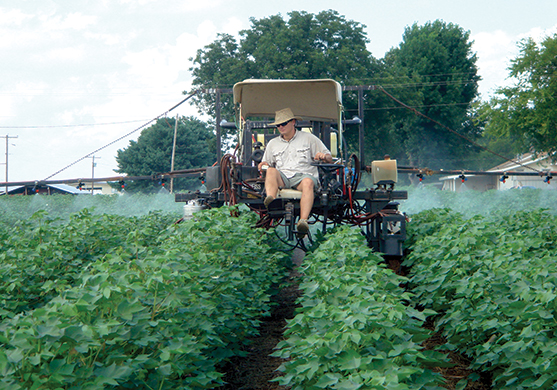| Current Issue | Past Issues | Subscribe | Ag Homepage |

Entomology and Plant Pathology
Pest Management by
The College of Agriculture’s Department of Entomology and Plant Pathology was not officially established until 1999, but it traces its roots back to 1896, when the Board of Trustees of what is now Auburn University established the Office of Experiment Station Entomologist.
In the 117 years since, Auburn entomologists and plant pathologists have been advancing the agricultural principles of the Morrill Land-Grant Act to make life better for citizens of Alabama and beyond by tackling issues tied to pests and crop production.
"What we do touches everyone everywhere—everyone,” says department chair Arthur Appel. “Everybody eats.”
The department’s goal, Appel says, is “identifying, understanding, and managing pest organisms in different environments, whether that’s out in a farmer’s field, in somebody’s house or on a golf course.”
It was crop protection that led Auburn, in 1908, to hire boll weevil expert Warren E. Hines as chair of the first entomology department in the new College of Agricultural Sciences. Based on a concept Hines had had success with in Texas, he employed the state’s first county demonstration agents—including the nation’s first black county agent—to improve farming methods, encourage diversification and teach farmers cultural control of the boll weevil.
In 1917, Auburn botany and plant pathology professor Wright Gardner organized a statewide academy of scientists with the goal of stimulating the scientific community of Alabama and emphasizing research at Auburn, and a century of agricultural achievements resulted.
Pioneering insect physiology and chemistry research in the 1960s led to the identification and synthesis of the sex pheromones of the lone star tick and cabbage looper, and from this work came the development of insect lures, traps and, ultimately, the new field of insect chemical ecology.
In the ’70s, Auburn scientists discovered that a fungal endophyte in pastures was causing fescue toxicosis, a condition that causes malnourishment in cattle and spontaneous abortions in horses, among other damaging symptoms. The result was the development of fungus-free fescue that has saved cattle producers across the South hundreds of millions of dollars.
Another milestone occurred later that decade, when plant pathologists at Auburn became the first scientists to define rhizobacteria, beneficial bacteria that colonize plants’ roots and promote growth and reduce pest vulnerability.
Two decades later, entomologists at Auburn began a research project that resulted in development of a horn fly vaccine for cattle. The vaccine, once available, will protect cattle against blood-sucking horn flies, which cause cattle to become anemic and lose weight and cost the beef industry $1 billion a year. The revolutionary vaccine will also reduce cattle stress, reduce the use of pesticides and help producers increase beef production and milk yield, improve leather quality and operate more efficiently.
Throughout its history, the department has contributed to the prevention and treatment of cotton rust, peanut fungal infections and lesser cornstalk borers; to various advancements in fertilizers and insecticides; to the development of integrated pest management systems that reduce pesticide use; and to multiple other innovations and cultivation strategies that fortify crops for better planting, harvesting and storage.
Currently, molecular toxicology research within the department is aimed at unraveling the genetics of insecticide resistance in mosquitoes.
“We are getting down to the point of looking at gene sequences that cause changes in resistance levels of insects to different insecticides,” Appel says. “We can now determine DNA sequences all the way to protein channels and note how they’ve changed shape and rendered insecticides ineffective.”
Appel, an urban entomologist, predicts that, as the nation becomes more populated and less rural, density-dependent pest problems will increase, as will insect-transmitted disease. Auburn’s Department of Entomology and Plant Pathology, he says, is preparing the next generation of scientists to meet those demands head-on.
“We are training scientists today who will lead the way in solving tomorrow’s problems,” Appel says.
The majority of the research conducted in the department requires an advanced command of science. As such, the department has a graduate program only.
“Although undergraduates may minor in entomology or plant pathology, the research-based curriculum of our master’s and Ph.D. programs require a level of biology most high school students haven’t mastered,” Appel says.
Under the tutelage of faculty that Appel says “absolutely love teaching,” graduate students in the department flourish and regularly garner awards for their research and are perpetuating the department’s mission of improving the quality of life for citizens of Alabama and beyond by tackling issues tied to pests and crop production.








